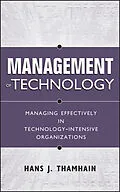* Presents assessment methods for organization and management
processes.
* Provides special tools and techniques for managing and organizing
R&D, new product, and project-oriented challenges.
* Includes real-world case studies.
Autorentext
HANS J. THAMHAIN, PHD, is Professor of Management and Director of the Technology and Project Management Programs at Bentley College in Waltham, Massachusetts. His industrial experience includes twenty years in high-technology management positions at GTE/Verizon, General Electric, Westinghouse, and ITT. Well known for his research on project team leadership, he is the author of more than seventy research papers and five professional reference books on project and technology management. In 2000, he received the IEEE Engineering Management Society's Engineering Manager of the Year Award.
Zusammenfassung
* Presents assessment methods for organization and management processes.
* Provides special tools and techniques for managing and organizing R&D, new product, and project-oriented challenges.
* Includes real-world case studies.
Inhalt
Preface xi
1 Challenges of Managing in High-Technology 1
1.1 Managing in Today's High-Tech Business Environment 2
1.2 MoT Scope and Focus 3
1.3 Developing a Formal Definition 5
1.4 The Special Role of Engineering Management 7
1.5 Global Dimensions 8
1.6 Impact of Internet and e-Commerce 10
1.7 Technology and Society 11
1.8 Future Trends 12
1.9 Summary of Key Points and Conclusions 13
1.10 Critical Thinking: Questions for Discussion 14
1.11 References and Additional Readings 14
2 Managing in an e-Business World 16
2.1 A Changing Environment 18
2.2 The Unique Nature of Managing Technology-Based Businesses 19
2.3 History of Managing Technology 25
2.4 Forces That Drive Technology Companies Today 27
2.5 Measuring Technology Content and Intensity 30
2.6 Case Study: Reprogramming Amazon 32
2.7 Summary of Key Points and Conclusions 37
2.8 Critical Thinking: Questions for Discussion 37
2.9 References and Additional Readings 38
3 Organizing the High-Technology Enterprise 40
3.1 Today's Business Processes Require Flexibility, Speed, and Efficiency 41
3.2 Organization Designs for Technology-Based Enterprises 42
3.3 Organizational Layers and Subsystems 44
3.4 Organizational Choices 46
3.5 Real-World Hybrids 54
3.6 Understanding the Working Environment 55
3.7 Summary of Key Points and Conclusions 57
3.8 Critical Thinking: Questions for Discussion 58
3.9 References and Additional Readings 59
4 Concurrent Engineering and Integrated Product Development 61
4.1 The Need for Effective Management Processes 63
4.2 A Spectrum of Contemporary Management Systems 64
4.3 Concurrent EngineeringA Unique Project Management Concept 64
4.4 Criteria for Success 66
4.5 Defining the Process to the Team 68
4.6 Understanding the Challenges 70
4.7 Understanding the Organizational Components 71
4.8 Recommendations for Effective Management 73
4.9 Conclusion 79
4.10 Summary of Key Points and Conclusions 80
4.11 Critical Thinking: Questions for Discussion 82
4.12 References and Additional Readings 82
5 Managing People and Organizations 86
5.1 Changing Roles of Managerial Leadership 87
5.2 Motivation and Technology Performance 90
5.3 Formal Models of Motivation 101
5.4 Leadership in Technology 110
5.5 The Power Spectrum in Technology Management 119
5.6 How to Make It Work: Suggestions for Increasing Effectiveness 123
5.7 Summary of Key Points and Conclusions 128
5.8 Critical Thinking: Questions for Discussion 129
5.9 References and Additional Readings 130
6 Managing Technology-Based Projects 133
6.1 Management of Technology Is Project-Oriented 135
6.2 Modern Project Management: A Continuously Evolving System 137
6.3 The Formal Project Management System 141
6.4 Framing the Project 143
6.5 Defining the Work 147
6.6 Managing Time and Resources 150
6.7 Defining the Project Organization 163
6.8 Using Project Management Tools Properly 166
6.9 A Model for Project Performance 167
6.10 Summary of Key Points and Conclusions 168
6.11 Critical Thinking: Questions for Discussion 169
6.12 References and Additional Readings 170
7 Measuring and Controlling the Work 172
7.1 The Challenges of Managerial Control in Technology 173
7.2 What We Know About Managerial Controls in Complex Work Environments 176
7.3 Characteristics of Effective Controls 186
7.4 How Do Managers Contol Technology-Intensive Work? 187
7.5 Recommendations for Using Management Controls Effectively 194
7.6 Conclusion 197
7.7 Summary of Key ...
